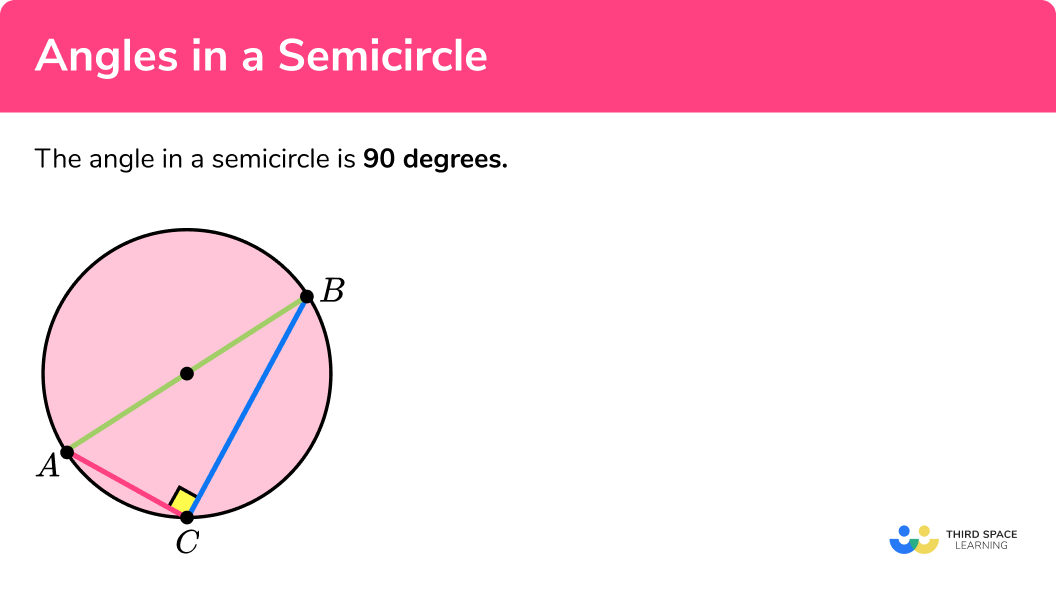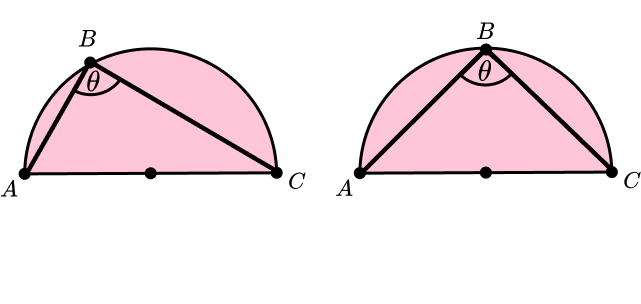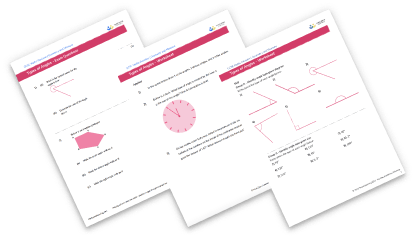One to one maths interventions built for KS4 success
Weekly online one to one GCSE maths revision lessons now available
In order to access this I need to be confident with:
Parts of a circle Angles in polygons Angles on a straight line Angles around a point Angles in parallel lines Types of trianglesThis topic is relevant for:

Angle In A Semicircle
Here we will learn about angles in a semicircle, including their application, proof, and using them to solve more difficult problems.
There are also circle theorem worksheets based on Edexcel, AQA and OCR exam questions, along with further guidance on where to go next if you’re still stuck.
What are angles in a semicircle?
Angles in a semicircle are degrees:
Angles in a semicircle are created when you join the two ends of the diameter to one point on the arc using chords.
In the diagram above, is the diameter of a circle that divides the circle into two. The two points and are joined to another point on the circumference using two chords. This triangle is a right-angle triangle with the degree angle touching the arc. This is the same for any point that is placed on the arc.
If the point is placed on another point in a semicircle, the result would be the same (the two chords would meet at the circumference at degrees). The angle in a semicircle is degrees.
What are angles in a semicircle?

Key parts of a circle needed for this theorem
- The diameter of the circle is the width of a circle, through the centre. The diameter is twice the length of the radius of a circle. In a semicircle, the diameter is the straight edge.
- A chord is a straight line that meets the circumference in two places. The longest chord in a circle is the diameter.
- A semicircle is half of a circle.
Subtended angles (in a semicircle):
An angle within a semicircle is created by two chords meeting at the two ends of the diameter. The diagrams below show the angle subtended by diameter from point for two different semicircles:

Proving that angles in the same segment are equal
To be able to prove this theorem, you do not need to know any other circle theorem. You just need to be confident with angles in a triangle.
| Step | Diagram | Description |
| 1 | We start with the diagram of a circle with triangle ABC where A, B, and C are points on the circumference and AB is the diameter of the circle, going through the centre. | |
| 2 | Connect the centre to the point C to create two smaller triangles. | |
| 3 | Let us inspect triangle OAC. | |
| 4 | OA and OC are radii and so triangle OAC is isosceles. This means that the two angles at A and C are equal, so we have labelled them both x. | |
| 5 | Let us now inspect triangle OBC. | |
| 6 | OB and OC are radii and so triangle OBC is also isosceles. This means that the two angles at B and C are equal, so we have labelled them both y. We cannot label them both x as they may not be the same as in triangle OAB. | |
| 7 | So now we have the triangle with the following angles. | |
| 8 | We can simplify the angle at C (angle ACB) to equal x + y as this angle is the sum of the two angles x and y from the original two triangles OAB and OBC. | |
| 9 | For the final step in this proof, we need to form and solve an equation to show that x + y = 90°. | As the sum of angles in a triangle is equal to 180°, we can state: As x + y = 90°, we can now state that the angle in a semicircle is 90 degrees. |
How to use the angle in a semicircle theorem
In order to use the fact that angles in a semicircle equal :
- Locate the key parts of the circle for the theorem.
- Use other angle facts to determine angles within the triangle.
- Use the angles in a semicircle theorem to state the other missing angle.
How to use the angle in a semicircle theorem


Angle in a semicircle worksheet

Get your free angle in a semicircle worksheet of 20+ questions and answers. Includes reasoning and applied questions.
DOWNLOAD FREE
Angle in a semicircle worksheet

Get your free angle in a semicircle worksheet of 20+ questions and answers. Includes reasoning and applied questions.
DOWNLOAD FREERelated circle theorems
Tangent of a circle is one of 7 circle theorems you will need to know. You may find it helpful to start with our main circle theorems page and then look in detail at the rest.
Angle in a semicircle examples
Example 1: standard diagram
is an arrowhead where is the centre of the circle and and lie on the circumference. Calculate the size of angle :
- Locate the key parts of the circle for the theorem.
Here we have:
- The angle
- is a diameter
- and are chords
- The angle
2Use other angle facts to determine angles within the triangle.
We already know that so we do not need to use any other angle fact to determine this angle for this example.
3Use the angles in a semicircle theorem to state the other missing angle.
As the angle in a semicircle is equal to , angle . We can therefore use the fact that angles in a triangle total to calculate the size of angle :
Example 2: cyclic quadrilateral
is a cyclic quadrilateral. is an isosceles triangle. Calculate the size of angle .
Locate the key parts of the circle for the theorem.
Here we have:
- The angle
- is a diameter
- and are chords
- The angle
Use other angle facts to determine angles within the triangle.
Triangle is interesting because it is an isosceles triangle but also a right angle triangle with the hypotenuse .
Using the theorem that the angle in a semicircle is , we can say that angle is equal to .
As the triangle is isosceles, the other two angles are equal to . This is important because we now know that angle is equal to , and so we can calculate the size of angle which is in the triangle containing θ.
Angle is therefore equal to:
We now have the following information added to the diagram:
Use the angles in a semicircle theorem to state the other missing angle.
As the angle in a semicircle is equal to , angle . We can therefore use the fact that angles in a triangle total to calculate the size of the inscribed angle :
Example 3: angles in the same segment
Points and lie on the circumference of the circle. is a diameter of the circle. and intersect at the point . Calculate the size of the angle .
Locate the key parts of the circle for the theorem.
Here we have:
- is a diameter
- and are chords
- The angle
- The angle
- The angle
Use other angle facts to determine angles within the triangle.
In order to find the angle θ, we need to know the size of the angle . is a straight line and so, as angles on a straight line total , we can calculate angle :
We can now calculate angle as angles in a triangle total :
Use the angles in a semicircle theorem to state the other missing angle.
As the angle in a semicircle is equal to , angle , we can, therefore, use the fact that angles in a triangle total to calculate the size of angle , and hence angle :
Example 4: angles in parallel lines
and are diameters of the circle with centre . and are parallel. Calculate the size of the angle .
Locate the key parts of the circle for the theorem.
Here we have:
- The angle
- and are diameters
- and are radii
- The angle
Use other angle facts to determine angles within the triangle.
is an isosceles triangle as and are radii. This means that the other two angles are the same and so:
Use the angles in a semicircle theorem to state the other missing angle.
As the angle in a semicircle is equal to , angle . Angle is therefore equal to:
Example 5: the alternate segment theorem
are points on a circle with centre . is a tangent to the circle through the point . and are parallel. Angle .
Calculate the size of angle .
Locate the key parts of the circle for the theorem.
Here we have:
- The angle
- is a diameter
- The angle
Use other angle facts to determine angles within the triangle.
The alternate segment theorem states that angles in the alternate segment are equal. The angle is, therefore, equal to . Also, as the lines and are parallel, the line is perpendicular to the line . So the angles at their intersection are equal to .
is a triangle. As we know two of the three angles, we can now calculate the size of angle , which will help us determine angle as the angles are congruent.
Use the angles in a semicircle theorem to state the other missing angle.
As the angle in a semicircle is equal to , angle . Angle is therefore equal to:
Example 6: angle at the centre
and are points on the circle with centre . Points and lie on a line of symmetry. Calculate the size of the angle .
Locate the key parts of the circle for the theorem.
Here we have:
- The angle
- is a diameter
- The angle
Use other angle facts to determine angles within the triangle.
The angle at the centre is twice the angle at the circumference and so angle .
As the shape is symmetrical, the angle is half the angle . So .
Use the angles in a semicircle theorem to state the other missing angle.
As the angle in a semicircle is , the angle . Due to the shape being symmetrical, angle is half of the angle . Angle .
We can now calculate the angle :
Common misconceptions
- Cyclic quadrilateral
The angles that are either end of the diameter total as if the triangle were a cyclic quadrilateral. They should total as the angle in a semicircle is .
- Isosceles triangles
The triangle is assumed to be isosceles and so the angles at either end of the diameter are the same.
- A diameter or a chord?
The angle at the circumference is assumed to be when the associated chord does not intersect the centre of the circle and so the diagram does not show a semicircle.
- Incorrect angle
The angle that is established as , is labelled as an angle by the diameter, and not the subtended angle at the circumference.
Practice angle in a semicircle questions
1. The points and are on the circumference of a circle. Calculate the size of angle .




- (angles in a semicircle)
2. The points and are on the circumference of a circle. Angle . Calculate the size of angle .




- (angles in a semicircle)
- (isosceles triangle)
3. The points and are on the circumference of a circle. and are chords that intersect at the point . Calculate the size of angle .




- (vertically opposite angles are equal)
- (angles in a semicircle)
4. The points and are points on the circumference of a circle. and intersect at the centre at an angle of . Calculate the size of angle .




- (vertically opposite angles are equal)
- (isosceles triangle)
5. The points and are on the circumference of a circle with centre . The chords and intersect at the point . is parallel to the tangent which passes through the point . Angle . Calculate the size of angle .




- (tangent meets radius at )
- (angles in a semicircle)
- (angles in a triangle)
6. The points and are on the circumference of a circle with centre . , and . Angle . Calculate the size of angle .




- (isosceles triangle)
- (angles in a semicircle)
Angle in a semicircle GCSE questions
1.
(a) The circle with centre has a diameter . Points and lie on the circumference of the circle and intersects with at the point . Calculate the size of angle marked . Show your working.
(b) Hence calculate the size of angle , marked .
(10 marks)
(a)
(1)
The angle in a semicircle is
(1)
(1)
Angles in a triangle
(1)
(1)
Vertically opposite angles are equal
(1)
(b)
(1)
The angle in a semicircle is
(1)
(1)
Angles in a triangle
(1)
2. is a triangle inscribed into a circle. Calculate the size of angle .
(4 marks)
(1)
The angle in a semicircle is
(1)
(1)
Angles in a triangle total
(1)
3.
(a) By calculating the size of angle , find the size of angle . State any reasons with your answer.
(b) What type of triangle is ?
(5 marks)
(a)
(1)
(1)
The angle in a semicircle is
(1)
(1)
(b)
Equilateral
(1)
Learning checklist
You have now learned how to:
- Apply and prove the standard circle theorems concerning angles, radii, tangents and chords, and use them to prove related results
The next lessons are
Still stuck?
Prepare your KS4 students for maths GCSEs success with Third Space Learning. Weekly online one to one GCSE maths revision lessons delivered by expert maths tutors.

Find out more about our GCSE maths tuition programme.